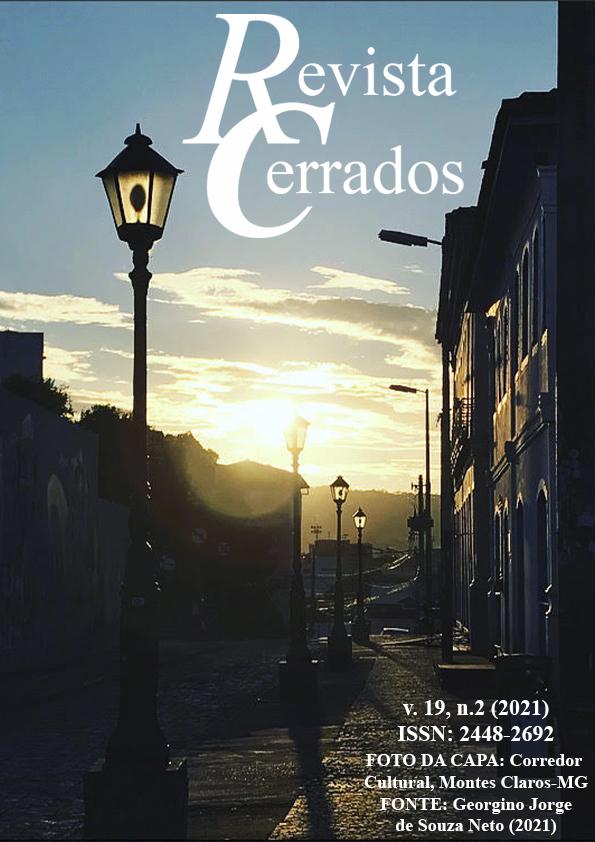An insight into extractivism in bryophyte flora
DOI:
10.46551/rc24482692202125Keywords:
Biodiversity, conservation, environment, mosses, Biodiversity, Conservation, Environment, MossesAbstract
Excessive exploitation of natural resources has had a significant impact on the environment, one example being the extraction of products of plant origin. Extractivism in Brazil is seriously discussed in relation to native species and at risk of extinction, such considerations are extremely important to highlight the need to preserve the flora and the environment. Therefore, this study aimed to review in the literature the research on extractivism in relation to the flora of bryophytes. A bibliometric network was created with respect to the publications of the SCOPUS database on the most discussed subjects in studies with bryophytes in the last 10 years. We also included a table with the record of 20 species of bryophytes that suffer with extractivism, according to the information available in the literature and supported by taxonomic studies for identification.
Downloads
References
AMÉLIO, L. A.; CARMO, D. M.; PERALTA, D., F. Briófitas do Parque Estadual de Campos do Jordão, Estado de São Paulo, Brasil. Hoehnea, São Paulo, v. 46, n. 2, p. 1 - 24, ago. 2019. Disponível em: <https://www.scielo.br/j/hoehnea/a/gjBtzL6SVqpGzQDZV5TRpcS/?lang=pt>. Acesso em: 10 jan. 2021.
BEGOSSI, A. Aspectos de economia ecológica: modelos evolutivos, manejo comum e aplicações. In: ROMEIRO, A. R.; REYDON, B. P.; LEONARDI, M. L. A. (Org.). Economia do meio ambiente: teoria, políticas e a gestão de espaços regionais. Campinas: UNICAMP, 1997. 384 p. p. 250 - 285.
BENNETT, A. F.; SAUNDERS. D. A. Habitat fragmentation and landscape change. In: SODHI, N. S.; EHRLICH, P. R. (Org.). Conservation biology for all. New York: Oxford University Press Inc., 2011. 368 p. p. 88-106 p.
BUCK, W. R. Pleurocarpous Mosses of the West Indies. New York: Memoirs of The New York Botanical Garden. 1998. 401 p.
CÂMARA, P. E. A. S. Musgos pleurocárpicos das matas de galeria da Reserva Ecológica do IBGE, RECOR, Distrito Federal, Brasil. Acta Botanica Brasilica, Belo Horizonte, v. 22, n. 2, p. 573 – 581, ago. 2008a. Disponível em: <https://www.scielo.br/j/abb/a/XSytM9LfvJjkNcCpVJRdF3q/?lang=pt>. Acesso em: 10 jan. 2021.
CÂMARA, P. E. A. S. Musgos acrocárpicos das Matas de Galeria da Reserva Ecológica do IBGE, RECOR, Distrito Federal, Brasil. Acta Botanica Brasilica, Belo Horizonte. v. 22, n. 2, p. 1027-1035, ago. 2008b. Disponível em: <https://www.scielo.br/j/abb/a/xLfdHTh8VP6B3bdczXnFQSC/?lang=pt>. Acesso em: 10 jan. 2021.
CANDIDO, A. B., et al. Relatório de qualidade ambiental, RQA 2016. São Paulo: Secretaria do Meio Ambiente do Estado de São Paulo/Coordenadoria de Planejamento Ambiental, 2016. 300 p.
CARDOSO DA SILVA, J. M.; CASTELETI, C. H. M. Estado da Biodiversidade da Mata Atlântica brasileira. In. GALINDO-LEAL, C.; CÂMARA, I. G. (Org.). Mata Atlântica: biodiversidade, ameaças e perspectivas. São Paulo: Fundação SOS Mata Atlântica, 2005. 471 p. p. 43-59.
CARMO, D. M.; PERALTA, D. F. Survey of bryophytes in Serra da Canastra National Park, Minas Gerais, Brasil. Acta Botanica Brasilica, Belo Horizonte, v. 30, p. 254-265, abr. 2016. Disponível em: <https://www.scielo.br/j/abb/a/YkvrWQZWXWcG3XzQHcq6xGj/?lang=en>. Acesso em: 10 jan. 2021.
CARMO, D. M.; LIMA, J. S.; AMÉLIO, L. A.; PERALTA, D. F. Briófitas do Parque Estadual da Serra do Mar, Núcleo de Santa Virgínia, Estado de São Paulo, Brasil. Hoehnea, São Paulo, v. 43, n. 2, p. 265-287. Jun. 2016. Disponível em: <https://www.scielo.br/j/hoehnea/a/7mwbv9WqcK6LTD95GFLpKFw/?lang=pt>. Acesso em: 10 jan. 2021.
COSTA, D. P. Briófitas. In: STEHMANN, J. R. et al. (Org.) 2009. Plantas da Floresta Atlântica. Rio de Janeiro: Jardim Botânico do Rio de Janeiro, 2009. 516 p. p. 13 – 18.
COSTA, D. P. Briófitas. In: FORZZA, R. C. et al.(Org.). Catálogo de plantas e fungos do Brasil. Rio de Janeiro: Jardim Botânico do Rio de Janeiro, 2010. 872 p. p. 452-521.
COSTA, D. P. et al. Synopsis of the Brazilian moss flora: checklist, distribution and conservation. Nova Hedwigia, Berlin, v. 93, p. 277-334, nov. 2011. Disponível em: <https://www.schweizerbart.de/papers/nova_hedwigia/detail/93/76348/Synopsis_of_the_Brazilian_moss_flora_checklist_dis>. Acesso em 10 jan. 2021.
COSTA, D. P.; PERALTA, D. F. Bryophytes diversity in Brazil. Rodriguésia, Rio de Janeiro, v. 66, n. 4, p. 1063-1071, set. 2015. Disponível em: <https://www.scielo.br/j/rod/a/JQHM5B54nzVJsvHHS3KMDGS/?lang=en>. Acesso em: 10 jan. 2021.
EVANGELISTA, R. Terrários: Plantando criatividade colhendo arte. Rio de Janeiro: Senac de São Paulo. 2019. 208 p.
FERNÁNDEZ, E. G.; SERRANO, A. M. V. Atividade Biológica das Briófitas. Rio de Janeiro: Ambito Cultural Edições Ltda, 2009. 96 p.
FRAHM, J. P. Dicranaceae: Campylopodioideae, Paraleucobryoideae. Flora Neotropica Monograph. New York: New York Botanical Garden, 1991. 237 p.
FRAHM, J. P. Ecology of tropical bryophytes. In: FRAHM, J. P. (Org.). Manual of tropical bryology. Berlin: Tropical Bryology, 2003, 196 p. p. 39 - 48.
FLORA DO BRASIL 2020. Jardim Botânico do Rio de Janeiro. Rio de Janeiro, RJ, 2020. Disponível em: http://floradobrasil.jbrj.gov.br/. Acesso em: 10 fev. 2021.
GOFFINET, B.; BUCK, W. R.; SHAW, A. J. Morphology, anatomy, and classification of the Bryophyta. In: GOFFINET, B.; SHAW, A.J. (Org.). Bryophyte biology. New York: Cambridge University Press, 2009. 535 p. p. 55 - 138.
GRADSTEIN, S. R; CHURCHILL, S. T.; SALAZAR-ALLEN, N. Guide to the bryophytes of Tropical America. New York: New York Botanical Garden, 2001. 577 p.
GRADSTEIN, S. R.; COSTA, D. P. The Hepaticae and Anthocerotae of Brazil. New York: New York Botanical Garden, 2003. 318 p.
GLIME, J. M. Bryophyte Ecology: Physiological Ecology. Michigan: Technological University, 2017. E-book.10 p. Disponínel em: <https://digitalcommons.mtu.edu/bryophyte-ecology1/13>. Acesso em: 20 abr. 2021.
HALLINGÄCK, T.; TAN, B. C. Past and present activities and future strategy of bryophyte conservation. Phytotaxa. Auckland, v. 9, p. 266- 274, set. 2010. Disponível em: < https://www.biotaxa.org/Phytotaxa/article/view/phytotaxa.9.1.15>. Acesso em:
TUPIASSÚ, A.; CARDOSO, M. J. A. Extrativismo, coleta e manejo de recursos vegetais de florestas. In: HARAGUCHI, L. M. M.; CARVALHO, O. B. (Org.). Plantas Medicinais: do curso de plantas medicinais. São Paulo. Secretaria Municipal do Verde e do Meio Ambiente. Divisão Técnica Escola Municipal de Jardinagem. 2010. 248 p. p. 28 - 30.
HOMMA, A. K. O. Extrativismo vegetal ou plantio: qual a opção para a Amazônia? Estudos Avançados. São Paulo, v. 26, n. 74, p. 167- 186, jan. 2012. Disponível em: < https://www.scielo.br/j/ea/a/4Gf73HkZPmhTzhLXTCk6zXK/?format=pdf&lang=pt>. Acesso em: 10 jan. 2021.
INSTITUTO BRASILEIRO DE GEOGRAFIA E ESTATÍSTICA (IBGE). Produção da extração vegetal e da silvicultura. Comunicação Social 24 de novembro de 2010. 2009: Brasil. Disponível em: <http://www.ibge.gov.br/home/presidencia/noticias/noticia_impressao.php?id_noticia=1760>. Acesso em: 20 jan. 2021.
INTERNATIONAL UNION FOR CONSERVATION OF NATURE (IUCN). Red List. United King, 2021. Disponível em: . Acesso: 20 jan. 2021.
JÁCOME, J; GRADSTEIN, S. R.; KESSLER, M. Responses of epiphytic bryophyte communities to simulated climate change in the tropics. In: Z. TUBA, N. G.; SLACK L. R. (Org.). Bryophyte ecology and climate change. New York: Cambridge University Press, 2011. 491 p. p. 191 - 207.
KOH, L. P.; GARDNER, T. A. Conservation in human-modified landscapes. In: SODHI, N. S.; EHRLICH, P. R. (Org.): Conservation biology for all. New York: Oxford University Press Inc., 2011. 369 p. p. 236 - 261.
LABORATÓRIO EM REDE DE HUMANIDADES DIGITAIS (LARHUD). Vosviewer. 2021. Disponível em: <http://www.larhud.ibict.br/index.php?Title=vosviewer>. Acesso em: 20 jan. 2021.
MARTINELLI, G. et al. Livro Vermelho da Flora endêmica do Estado do Rio de Janeiro. Rio de Janeiro: Jardim Botânico do Rio de Janeiro. 2018. 456 p.
MITTERMEIER, R. A. et al. Hotspots revisited. Mexico: CEMEX, 2004. 392 p.
MORAES, E. N. R.; LISBOA, R. C. L. Diversidade, taxonomia e distribuição por estados brasileiros das famílias Bartramiaceae, Brachytheciaceae, Bryaceae, Calymperaceae, Fissidentaceae, Hypnaceae e Leucobryaceae (Bryophyta) da Estação Científica Ferreira Penna, Caxiuanã, Pará, Brasil. Acta Amazonica. Manaus, v. 39, n. 4, p. 773 – 792, ago. 2009. Disponível em: <https://www.scielo.br/j/aa/a/Frh8qf8X67p8ttC7hFqFMVz/abstract/?lang=pt>. Acesso em: 10 jan. 2021.
NEGRELLE, R. R. B.; ANACLETO, A. Bromeliads wild harvesting in State of Paraná. Ciência Rural, Santa Maria, v. 42, n. 6, p. 981 – 986, jun. 2012. Disponível em: <https://periodicos.ufsm.br/cr/article/view/58453/37421>. Acesso em: 10 jan. 2021.
NEGRELLE, R. R. B.; BORDIGNON, S. E.; YANO, O. Sphagnum (velvet) species used by rural communities at the Guaratuba EPA, Paraná State, Brazil. Acta Scientiarum. Maringa, v. 4, n. 2, p. 163 – 171, out. 2012. Disponível em: <https://periodicos.uem.br/ojs/index.php/ActaSciBiolSci/article/view/7055>. Acesso em: 10 jan. 2021.
OLIVEIRA, R. F.; ALVES, J. W. S. Mudanças climáticas globais no Estado de São Paulo. São Paulo: Secretaria do Meio Ambiente do Estado de São Paulo/Coordenadoria de Educação Ambiental. 2014. 108 p.
PALHARES, V. L.; COSTA, P. C. Desenvolvimento rural e extrativismo: a cadeia produtiva do musgo na comunidade rural André do Mato Dentro, Santa Bárbara/MG. Revista Cerrados. Montes Claros, v. 16, n. 1, p. 3 - 22, jun. 2018. Disponível em: <https://www.periodicos.unimontes.br/index.php/cerrados/article/view/1264>. Acesso em: 10 jan. 2021.
SÉRGIO, C.; FIGUEIRA, R.; MENEZES, R. Modeling the distribution of Sematophyllum substrumulosum (Hampe) E. Britton as a signal of climatic changes in Europe. In: TUBA, Z.; SLACK, N. G.; STARK, L. R. (Org.). Bryophyte ecology and climate change. New York: Cambridge University Press, 2011. 491 p. p. 427 - 439.
SCHERER, H. J.; ESSI, L.; PINHEIRO, D. K. O conhecimento da biodiversidade: um estudo de caso com estudantes de graduação de uma universidade brasileira. Revista Monografias Ambientais. Santa Maria. v. 14, n. 2, p. 49 – 58, ago. 2015. Disponível em: < https://periodicos.ufsm.br/remoa/article/view/18904>. Acesso em: 10 jan. 2021.
SHAW, P. Estimating local extinction rates over successive time frames. Biological conservation. Redgorton, v. 121, n. 2, p. 281-287, jan. 2005.
STEPHAN, P.; VEUGELERS, R.; WANG, J. Reviewers are blinkered by bibliometrics. Nature, London, v. 544, p. 411 - 412, apr. 2017. Disponível em: <https://www.nature.com/articles/544411a.pdf>. Acesso em: 15 jan. 2021.
STEHMANN, J. R. et al. Diversidade taxonômica na Floresta Atlântica. In: STEHMANN, J. R. et al. (Org.). Plantas da Floresta Atlântica. Rio de Janeiro: Jardim Botânico do Rio de Janeiro, 2009. 516 p. p. 10 – 12.
VANDERPOORTEN, A.; GOFFINET, B. Introduction to bryophytes. New York. Cambridge University Press, 2009. 303 p.
SHARP, A. J.; CRUM, H.; ECKEL, P. The Moss Flora of Mexico. New York: Memoirs of The New York Botanical Garden, 1994. 1113 p.
VITALI, V. M. V. O que é biodiversidade? In: BARBOSA, L. M. (Org.). Biodiversidade: Cadernos de Educação Ambiental. São Paulo: Secretaria do Meio Ambiente do Estado de São Paulo/Instituto de Botânica. 2010. 17-30 p. p. 60.
YANO, O.; PERALTA, D. F. Flora da Serra do Cipó, Minas Gerais: Briófitas (Anthocerotophyta, Bryophyta e Marchantiophyta). Boletim de Botânica da Universidade de São Paulo. São Paulo, v. 29, n. 2, p. 135 – 211, jan. 2011. Disponível em: < https://www.revistas.usp.br/bolbot/article/view/29481>. Acesso em: 10 jan. 2021.
YANO, O.; PERALTA, D. F.; BORDIN, J. Brioflora da Ilha do Cardoso. São Paulo, Brasil. São Carlos: Rima Editora, 2019. 644 p.
Yu, Y. et al. A bibliometric analysis using VOSviewer of publications on COVID-19. Annals of Translational Medicine. Hong Kong, v. 8, n. 13, p 816 - 827, jun. 2020. Disponínel em: < https://atm.amegroups.com/article/view/46197/html>. Acesso em: 10 jan. 2021.
Published
How to Cite
License
Copyright (c) 2021 Revista Cerrados

This work is licensed under a Creative Commons Attribution-NonCommercial-NoDerivatives 4.0 International License.
In this journal, the copyrights for published articles belong to the author (s), with the rights of the first publication belonging to Revista Cerrados. The articles are publicly accessible, free to use, their own assignments, educational assignments and non-commercial applications.


















